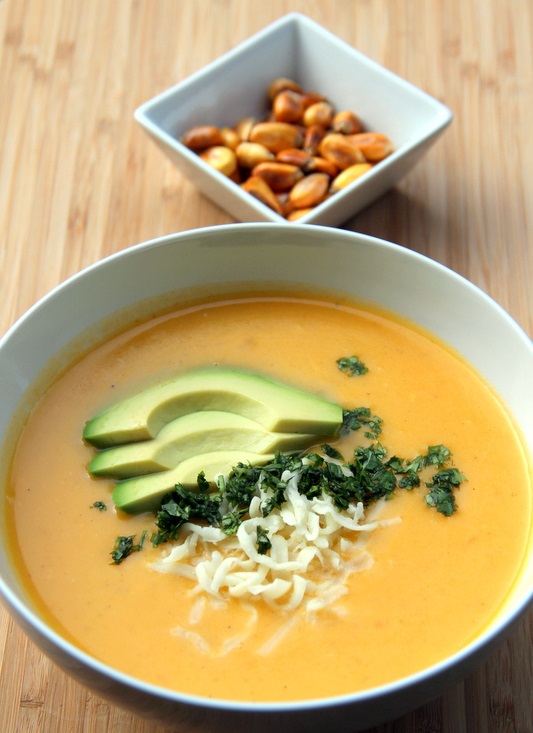Ecuadorian cuisine is diverse, varying with altitude, and associated agricultural conditions. Pork, chicken, beef, and cuy (guinea pig) are popular in the mountainous regions, and are served with a variety of carbohydrate-rich foods, especially rice, corn, and potatoes.
Ecuadorian cuisine
A popular street food in mountainous regions is hornado, consisting of potatoes served with roasted pig. Some examples of Ecuadorian cuisine in general include patacones (unripe plantains fried in oil, mashed up, and then refried), llapingachos (a pan seared potato ball), and seco de chivo (a type of stew made from goat).
 A wide variety of fresh fruit is available, particularly at lower altitudes, including granadilla, passionfruit, naranjilla, several types of bananas, uvilla, taxo, and tree tomato.
A wide variety of fresh fruit is available, particularly at lower altitudes, including granadilla, passionfruit, naranjilla, several types of bananas, uvilla, taxo, and tree tomato.
Regional differences
There are several Ecuadorian dishes that are typical to the various regions in the country. For example, costeos (people from the coast) prefer fish, beans, and plantains (unripened banana like fruits), while serranos from the mountainous regions prefer meat, potatoes, rice, and white hominy (mote).
Regional examples include ceviche from the coast, which is prepared in many different ways, but basically consist of seafood (fish, shrimp, etc.) marinated in lime juice, as well as cassava (yuca) bread, plantains served with crushed peanuts or salprieta, and encebollado, the most popular dish on the coast, that contains a marinade with large chunks of fish, onions, and various regional spices. In the province of Esmeraldas most of their typical dishes are cooked with coconut.
Seafood is very popular in the coast, where fish, prawns, shrimp and crab, clams, etc. are key parts of the diet. Plantain and peanut-based dishes are the basis of many coastal meals, which are usually served in two courses. The first course is caldo (soup), which may be aguado (a thin soup, usually with meat) or caldo de leche, a cream vegetable soup.
The second course might include rice, meat, or fish with a menestra (lentil stew), and salad or vegetables. Patacones (fried green plantains with cheese) are popular side dishes with coastal meals. Some of the typical dishes in the coastal region are ceviche, pan de almidn, corviche, guatita, papas con cuero, encebollado, and empanadas; in the mountain region: hornado, fritada, humitas, tamales, llapingachos, lomo saltado, and churrasco.
The food is somewhat different in the southern mountainous areas, featuring typical Loja food such as repe, a soup prepared with green bananas; cecina, roasted pork; and miel con quesillo or "cuajada", as dessert. In the rainforest, a dietary staple is the yuca, elsewhere called cassava.
The starchy root is peeled and boiled, fried, or used in a variety of other dishes. It's also used as a bread, and has spread throughout the nation, most notably, to Quito where a company sells the native pan de yuca in a new sense; different types sold with frozen yogurt. Many fruits are available in this region, including bananas, tree grapes, and peach palms.
Typical meal
Ecuadorian cuisine traditionally consists of two dishes, a soup and a rice platter. For the most part, Ecuador is known not only for its bananas, and all the dishes made from them, but for its starch consumption of products like potato, bread, rice, and yuca. Traditionally any of these factors can be found in either the soup or the rice platter that may be served.
Most regions in Ecuador follow the traditional three course meal of sopa (soup) and segundo (second dish), which includes rice and protein such as beef, poultry, pork, or fish. Then dessert and coffee are customary. Dinner is usually lighter and sometimes just coffee or agua de remedio (herbal tea, lit. "remedy water") with bread.
Catholic influence
Besides the regions, there are several typical Ecuadorian dishes consumed on special occasions. During Easter, the fanesca is traditionally served all over Ecuador. Fanesca (a fish soup including several types of beans, lentils, and corn) is often eaten during Lent and Easter. During the week before the commemoration of the deceased or All Souls' Day, the fruit beverage colada morada is typical, accompanied by t'anta wawa which is stuffed bread shaped like children.